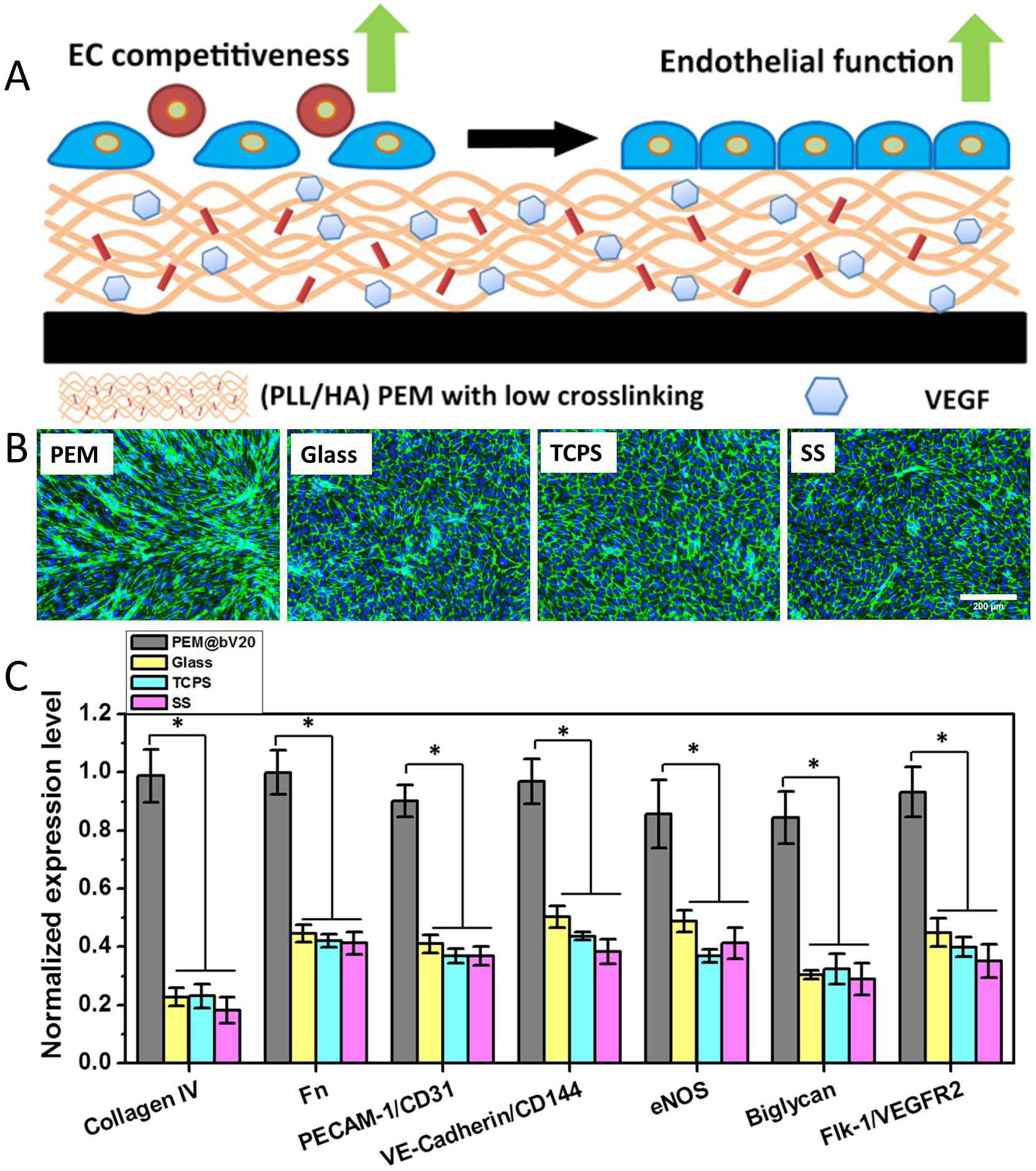Enhancing endothelialization by promoting endothelial cell competitiveness and endothelial function on soft polyelectrolyte multilayer film with matrix-bound VEGF
-
1
Zhejiang University, Department of Polymer Science & Engineering, China
Rapid endothelialization of vascular implant has been regarded as an efficient solution to eliminate undesired post-implanting symptoms[1]. Promoting endothelial cell (EC) competitiveness over smooth muscle cell (SMC)[2],[3] and subsequent endothelial function[4] play significant role in success of rapid-endothelialization. To this end, we employed poly(L-lysine)/hyaluronan (PLL/HA) polyelectrolyte multilayer film (PEM)[5] with low crosslinking degrees as soft substrate and incorporated vascular endothelial growth factor (VEGF) in soft PEM in a matrix-bound manner. Adhesion and spread of both ECs and SMCs were promoted on the PEM with matrix-bound VEGF, which was associated with VEGF receptor 2. By regulating amount of VEGF incorporated in the PEM, selective EC adhesion was achieved. In addition, ECs were proliferating on PEM with matrix-bound VEGF while SMCs did not, which indicated that PEM with matrix-bound VEGF could efficiently promote EC competitiveness over SMC. Furthermore, the formed EC monolayer on the PEM with matrix-bound VEGF showed better integrity, higher release level of nitric oxide and higher expression level of endothelial function related genes than those on the substrates with high stiffness, which highlighted the benefit of soft substrate in endothelial function. This study provided a promising strategy of surface modification for enhancing endothelialization by promoting both EC competitiveness and endothelial function, which is of great potential in developing a new generation of vascular implants.

Zhejiang Provincial Natural Science Foundation of China (LR15E030002); National Natural Science Foundation of China (51333005, 21374095); the National Basic Research Program of China (2011CB606203); International Science & Technology Cooperation Program of China (2014DFG52320)
References:
[1] Otsuka F, Finn AV, Yazdani SK, Nakano M, Kolodgie FD, Virmani R. The importance of the endothelium in atherothrombosis and coronary stenting. Nat Rev Cardiol. 2012;9:439-53.
[2] Wei Y, Ji Y, Xiao LL, Lin QK, Xu JP, Ren KF, et al. Surface engineering of cardiovascular stent with endothelial cell selectivity for in vivo re-endothelialisation. Biomaterials. 2013;34:2588-99.
[3] Chang H, Ren K-f, Wang J-l, Zhang H, Wang B-l, Zheng S-m, et al. Surface-mediated functional gene delivery: An effective strategy for enhancing competitiveness of endothelial cells over smooth muscle cells. Biomaterials. 2013;34:3345-54.
[4] van Beusekom HMM, Whelan DM, Hofma SH, Krabbendam SC, van Hinsbergh VWM, Verdouw PD, et al. Long-term endothelial dysfunction is more pronounced after stenting than after balloon angioplasty in porcine coronary arteries. J Am Coll Cardiol. 1998;32:1109-17.
[5] Crouzier T, Fourel L, Boudou T, Albiges-Rizo C, Picart C. Presentation of BMP-2 from a Soft Biopolymeric Film Unveils its Activity on Cell Adhesion and Migration. Adv Mater. 2011;23:H111-H8.
Keywords:
mechanical property,
endothelialization,
Ultra-thin coating,
Cell functionality
Conference:
10th World Biomaterials Congress, Montréal, Canada, 17 May - 22 May, 2016.
Presentation Type:
Poster
Topic:
Biomaterials for cardiovascular applications, vascular grafts and embolic devices
Citation:
Chang
H,
Ren
K,
Hu
M,
Zhang
H and
Ji
J
(2016). Enhancing endothelialization by promoting endothelial cell competitiveness and endothelial function on soft polyelectrolyte multilayer film with matrix-bound VEGF.
Front. Bioeng. Biotechnol.
Conference Abstract:
10th World Biomaterials Congress.
doi: 10.3389/conf.FBIOE.2016.01.02001
Copyright:
The abstracts in this collection have not been subject to any Frontiers peer review or checks, and are not endorsed by Frontiers.
They are made available through the Frontiers publishing platform as a service to conference organizers and presenters.
The copyright in the individual abstracts is owned by the author of each abstract or his/her employer unless otherwise stated.
Each abstract, as well as the collection of abstracts, are published under a Creative Commons CC-BY 4.0 (attribution) licence (https://creativecommons.org/licenses/by/4.0/) and may thus be reproduced, translated, adapted and be the subject of derivative works provided the authors and Frontiers are attributed.
For Frontiers’ terms and conditions please see https://www.frontiersin.org/legal/terms-and-conditions.
Received:
27 Mar 2016;
Published Online:
30 Mar 2016.
*
Correspondence:
Dr. Hao Chang, Zhejiang University, Department of Polymer Science & Engineering, Hanghzou, China, chang198852@126.com
Dr. Kefeng Ren, Zhejiang University, Department of Polymer Science & Engineering, Hanghzou, China, Email1
Dr. Mi Hu, Zhejiang University, Department of Polymer Science & Engineering, Hanghzou, China, sunflowerhm@126.com
Dr. He Zhang, Zhejiang University, Department of Polymer Science & Engineering, Hanghzou, China, 3090100837@zju.edu.cn
Dr. Jian Ji, Zhejiang University, Department of Polymer Science & Engineering, Hanghzou, China, jijian@zju.edu.cn